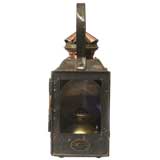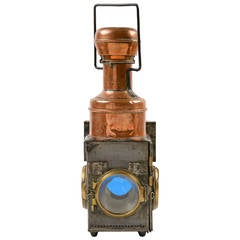French Railroad Lantern
Recent Sales
Antique 19th Century French Decorative Objects
Steel, Copper
Antique Mid-19th Century French Lanterns
Brass, Copper, Steel
Antique 19th Century French Lanterns
Copper, Iron, Brass
Antique Late 19th Century French Lanterns
Copper
Early 20th Century French Lanterns
Brass, Copper
Early 20th Century French Lanterns
Brass, Copper
Antique Early 1900s French Lanterns
Brass, Iron
Vintage 1910s French Lanterns
Brass, Copper, Iron
Early 20th Century Lanterns
Brass, Copper, Iron
Antique 19th Century French Lanterns
Iron, Tôle
Early 20th Century French Belle Époque Wall Lights and Sconces
Brass
Early 20th Century French Belle Époque Wall Lights and Sconces
Brass
Early 20th Century French Lanterns
Metal
Early 20th Century French Lanterns
Iron
Early 20th Century French Lanterns
20th Century Lanterns
Brass
Antique 19th Century French Decorative Objects
Brass
Finding the Right Lanterns for You
Whether you’re in search of a functional fixture to help illuminate a room or just a minimalist ornamental touch, the choice of lighting is important. Selecting the perfect vintage, new or antique lanterns can transform an otherwise monotonous space in your home.
In the 1700s, lanterns became widely popular when accessibility broadened for whale oil, as fuel for lamps was one of its earliest uses. Lantern design evolved considerably during the mid- to late 19th century, when a powerful, adaptable fuel came into play: kerosene. Portable and immediately sought after, kerosene lamps were traditionally surrounded by a glass globe or tube that sat on a metal frame to protect the flame from spreading or extinguishing. (While reproductions abound, antique kerosene lanterns have since become collector's items.)
Later, in 1862, John H. Irwin created coil oil lamps, which were designed for coal oils as well as kerosene and lessened the risk of fire. They required plentiful oxygen to remain lit, and with refinements, the lamps could be used indoors. Lanterns increasingly came to be part of commercial spaces such as museums and theaters, and over time, lighting artisans worked to refine and perfect these innovative fixtures so that they weren’t only practical but also elegant, sophisticated additions to home decor.
Antiques inject a touch of classical chic into any space. With the right lantern, you could also deepen the impact of the collection of vases and vessels, sculptures or other decorative objects in a living room or dining room. It’s essential to find a balance between utility and aesthetics when choosing the perfect vintage–style lantern for your space, and the right lighting decisions can determine the underlying mood of a room as well as enhance the choices you’ve made for your home’s decor. While old-time charm is something to be cherished, there is lots to love in modern lanterns from today’s top furniture designers.
On 1stDibs, search by creator to find lanterns crafted by the likes of Woka Lamps, Barovier & Toso and Material Lust or browse the collection by style. From today’s standouts to mid-century modern classics to Art Deco–era innovations, find the best vintage, new or antique lantern for you now.
- 1stDibs ExpertNovember 26, 2024To identify antique railroad lanterns, first see if you can locate a maker's mark on the bottom. Using trusted online resources, you can determine who produced your lantern based on these markings, and then you can research the company to find out when it was in business and making lanterns similar to yours. To be considered an antique, a railroad lantern must be at least 100 years old. If you can't find a maker's marking, it's generally necessary to use the characteristics of a lantern to date it. Because this can be difficult without experience and training, you may wish to seek the opinion of a certified appraiser or knowledgeable antique dealer when identifying unmarked railroad lanterns. Explore a selection of lanterns on 1stDibs.
- 1stDibs ExpertOctober 7, 2024The difference between a railroad lamp and a lantern comes down to design and function. Railroad lamps are stationary lighting fixtures that were used to illuminate railroad tracks and platforms. They usually feature a heavy sheet or cast metal body and have lenses that make their lighting more intense. Intended to be portable, lanterns are generally smaller and usually feature a metal frame, a glass shade and no lenses. On 1stDibs, explore a selection of railroad lamps and lanterns.
Read More
My Father Was Obsessed with This French Art Deco Tiger Lamp
The 1920s design is a thrilling combination of saturated colors, ancient motifs and modern aesthetics.
Hans Bergström’s Monumental Chandeliers Are Made for Grand Spaces
Designed by a giant of Swedish lighting, the large-scale fixtures bring major drama.
This Paavo Tynell Chandelier Is a Radiant Bouquet
The alluring pendant light exemplifies the designer’s winsome mid-career work.
Ettore Sottsass Captures a Shooting Star in This Rare 1970s Floor Lamp
Before founding the Memphis Group, Sottsass bent the rules of lighting design with the wonderfully wavy Cometa.
You Don’t Need a Fictional Fairy to Get This Real Pinocchio Lamp
Warm chalet style meets cool Bauhaus functionality in Pietro Cascella’s cleverly carved creation.
Why Is Italy Such a Hotbed of Cool Design?
Patrizio Chiarparini of Brooklyn’s Duplex gallery sheds light on the lasting legacy of Italy’s postwar furniture boom.
With a High-Tech Flagship and Cool Collabs, Lladró Is Breaking the Mold for Porcelain Production
Thanks to its new leadership, the Spanish maker of figurines, busts and lighting is on a mission to update the art of porcelain for the 21st century.
Christopher Tennant’s Lamps and Dioramas Evoke Sunny Days and Seaside Locales
The former magazine editor blends elements of the Far East and America’s eastern shores, bringing wit and delight to his handmade, upcycled designs.

